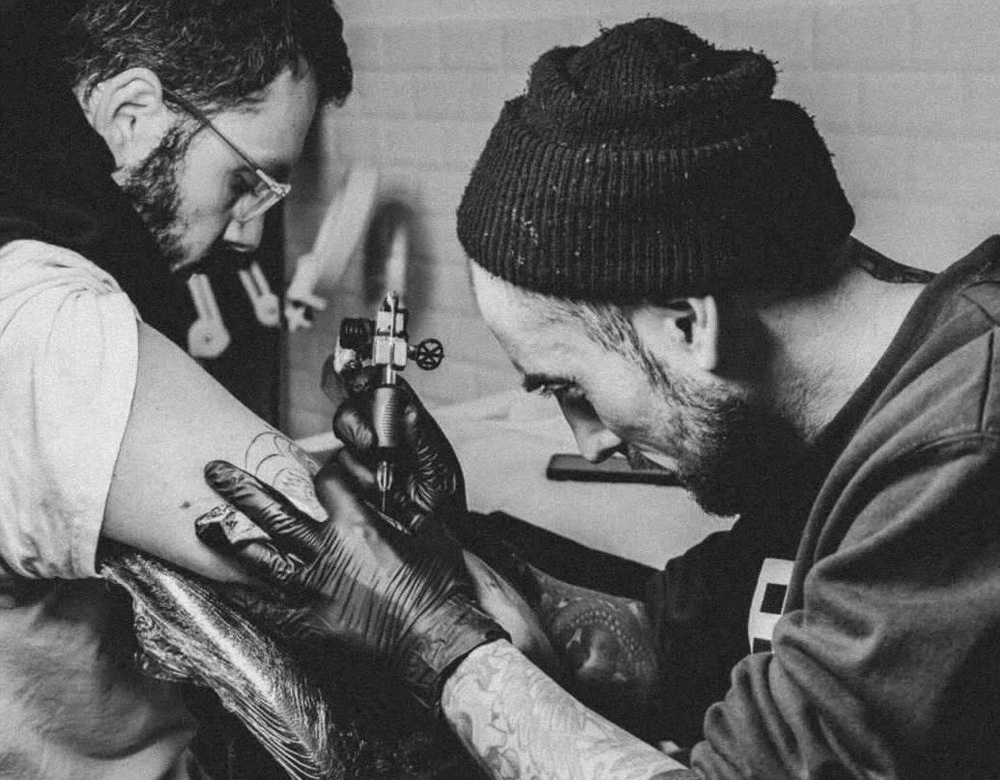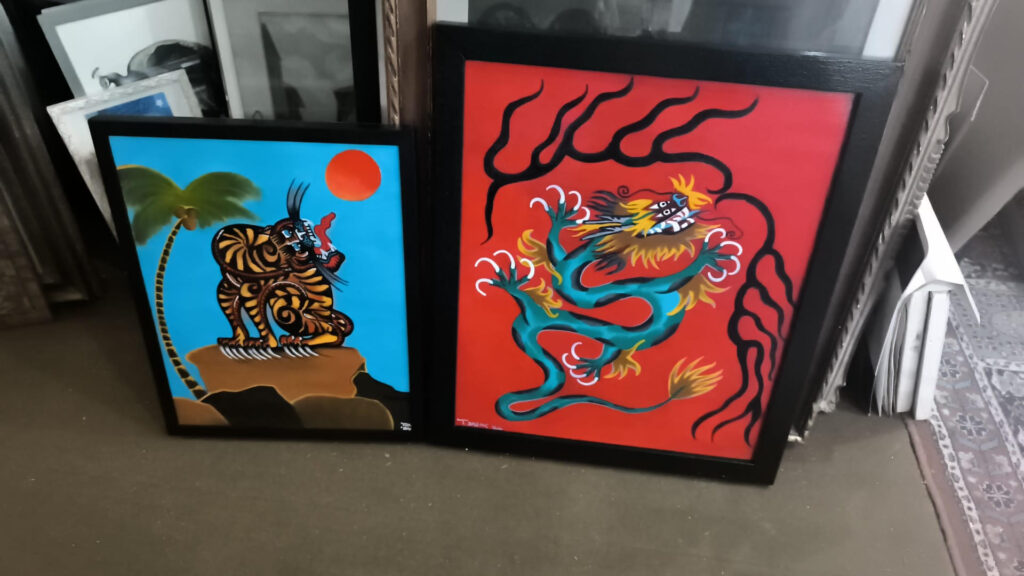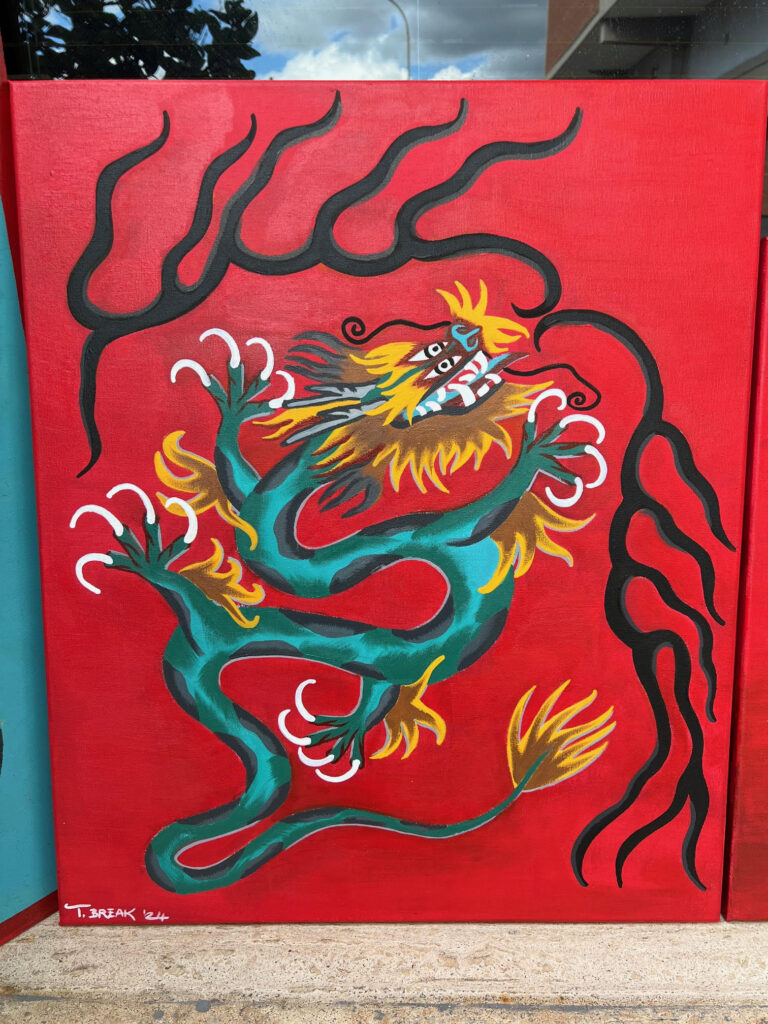Turi Break
Year of birth: August 11th 1985.
Where do you live: I’m in Tuscany right now with my super Girl Giovanna that give me every day the power to be who I am and our dog Django.
Your education:
High Classical School in Palermo.
Started to study History at the University of Palermo.
A master class in sound design and music business at NABA Milan.
Describe your art in three words: PMA. Positive Mental Attitude.
Instagram
How did your journey as a tattoo artist begin, and how has it evolved over the years?
Well, I discovered the tattoo world and became passionate about it subsequently at the same time I discovered the hardcore punk music and scene during my high school years. It was a blast. Seeing all those kids full of traditional tattoos around the social spaces and punk squat during that period (2000 – 2001) and starting to buy vinyl and records about American hardcore bands was great. Lots of inspiration, attitude, words, and tattoos, of course. So I had a first experience with an old friend of mine from Palermo, we were 19 years old. He started to make tattoos in that period, and he gave me my first 2 tattoos in the same day, at home, his first home outside Palermo, our city. We were in Bologna, and it was totally crazy. After that, I started to collect tattoos on my skin, going to a lot of tattoo conventions, first of all, where I met a lot of great tattoo artists of traditional and Japanese culture. In 2006, exactly, I did my first tattoo on a kid. Horrible, to be honest. That was the beginning of this history.
What draws you to American traditional tattoo styles and Japanese/Oriental art, and how do you integrate these influences into your paintings?
The stories behind the subjects of traditional American tattoos are fascinating, mystical, romantic, true. This has always fascinated me. Hearts, knives, daggers, skulls, women’s faces, tigers, stormy seas exist because there are stories that have been told and then told again since the early years of the history of this art. We don’t know if all these are true or not, and we will never know, and this is precisely what characterizes traditional tattoos and traditional art, becoming legendary. This is the way for me of a true cooperation between every tattoo flash and every subject of my art, on paper or canvas. About the Japanese tattoo and all Japanese art, well, I can only say that there is no such high-level technicality, especially regarding details, in any type of pictorial or tattoo genre. The religious, chromatic, and visual meanings of Japanese enchant me, and I believe they are incomparable, ever.
How do you balance your roles as a tattoo artist, painter, musician, and author? Do these different creative outlets influence each other?
Of course, yes. I think that having experience with the hardcore punk world first of all, in addition to the artistic and political influence of my family—my mother is also an artist—has done a lot. By the way, graffiti influenced me so much since I was a teenager. I do graffiti right now as well. Understanding spaces, always looking beyond, wanting to achieve more and more goals, being hungry for information, wanting practical as well as artistic experiences—this binds the various parts of me; well, it’s the exact construction of me. Hardcore punk music with all the positive mental attitude inside, art and creativity have always walked together with me. No space for superficiality, and mostly autonomously, learning from the ‘do it yourself’ practices typical of the punk environment.
Can you tell us about a memorable tattoo project that had a significant impact on your artistic style?
It’s really difficult. Every tattoo and subject I wear has a deep meaning or reminds me of an important moment or place. The same goes for the works that I draw myself or that I tattoo on someone. Certainly, the factory that I carry in the middle of my chest is memorable for me for the meeting and the experience lived in contact with the tattoo artist who did it for me, the great Rudy Fritch, who has always been an artistic reference and a master for me. The same goes for the signature of one of the founders of Californian tattoo, the best Good Time Charlye, that I had the honor of having tattooed by him in America a few years ago. A memorable moment for me in relation to my works is, I think, having covered a swastika on the arm of a tortured Afghan political refugee. It was done to him during his years of imprisonment, and once he found his daughter, he asked me to cover it for him. I offered him a swallow, so it was, and together we freed his skin from that nightmare.
What challenges do you face when translating tattoo art onto canvas or paper, and how do you approach them?
It’s a challenge. Building and then painting a traditional tattoo table on paper requires an almost copying technique. I would say that over time, if you are passionate and willing to study, you always assimilate and replicate. The black colors are very useful, and the shades give shape to each subject; the solidity of the line especially creates everything. Transferring this onto canvas is very difficult as far as I’m concerned. I always try to remove the maximum of dark shades to give space to soft, pastel, brighter, and more open colors. I try to give more volume also through the layers of color applied. This leads me to often eliminate too many details and enlarge the shapes. I love transferring traditional animal subjects onto canvas: tigers, eagles, snakes, dragons. I must say that having done a lot of graffiti helps me a lot with the combination of colors and the choice of patterns or background shades. It’s a challenge, but it’s also a game, and I will continue to throw away at least three or four works before arriving at the final one.
Could you share your experience writing about the underground history of Italy? How did your background as an artist and musician shape the book?
It was simple from the beginning because it was and is what I consciously chose to live. Once I got in touch with the punk and political as well as musical world around me, all of this became part of me. You can’t find the ease with which, within these environments, you can form solid friendly relationships and maintain them over time anywhere else. The music, from the rhythm to your days. The colors, ideas, stimuli, and approach to life itself come from there. In fact, the idea of writing that book “Black Hole, a look at the Italian underground” together with the Turin editors Eris was not only to give a real voice to those who had always been there and to those who are still there but to tell in a very simple mood the great story of the underground to all those who have never had any idea. I was born so far—Palermo is out, it was out every time from the rest of Italy and Europe—but I had the chance, and I traveled a lot with my bands without ever having too much money in my pocket for this. I had the opportunity to meet many activists, musicians, authors, artists, and tattooers in this. It’s my life. This comes with many pros and many cons.
How do you think your Sicilian heritage influences your artistic approach and choice of subjects?
I owe everything not only to being Sicilian but above all to my mother. Since I was very little, there were more times when she took me around Palermo and Catania to observe the monuments and told me the fantastic stories of the people in Sicily than anything else. At home, we always drew together with art or painting books next to us. The Bellafiore, a well-known historical guide to the city of Palermo where inside you can find all the city monuments drawn and told in a totally romantic way, is a book that I will never forget. And I also owe it to the socio-political and historical charisma of my father who gave me the fortune of living part of our years in Cefalu, one of the most historic places in Sicily, telling me about the professions and economy of our land, part of my Sicilian identity precisely which it is perceptible in what I draw.




Leave a Reply